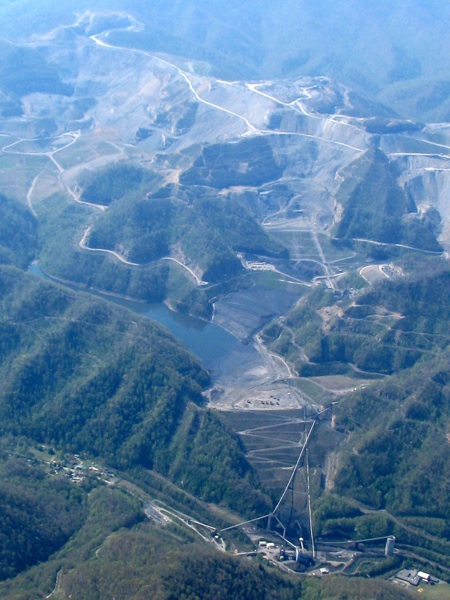In memory of Jeremy Davidson
“It hurled like a cannonball into Dennis and Cindy Davidson’s house, right through the wall of the bedroom and onto the bed where 3-year-old Jeremy was sleeping. The huge boulder continued its path, crashing through a closet before finally stopping at the foot of 8-year-old Zachary’s bed. Zachary would be fine. Jeremy was crushed to death. A bulldozer operator widening a road at a strip mining operation atop Black Mountain had unknowingly dislodged the half-ton boulder that August night. And now, more than four months later, Jeremy’s death is still being felt across the coal mines of southwestern Virginia. For many residents, the toddler’s death has come to symbolize what they consider the companies’ and the state’s callous disregard for their safety.”
After Boy Is Killed by Boulder, Va. Residents Cite Disregard for Safety
Carol Morello
Washington Post, January 6, 2005, APPALACHIA, Va
.
 Over 500 mountains, 1.5 million acres of hardwood forests, and 1,200 miles of streams, along with historic mountain communities, have been destroyed by mountaintop removal. Antrim CaskeyThe first bipartisan Senate hearing on mountaintop removal in a generation takes place today, with expert testimony coming from Goldman Prize Award winner Maria Gunnoe of West Virginia, among many others on the impact of mountaintop removal strip mining on communities and watersheds, and the reality of dumping of mining waste into streams. Over1,300 miles of streams have been sullied and jammed by mountaintop removal operations. Over 500 mountains have been blown to bits.
Over 500 mountains, 1.5 million acres of hardwood forests, and 1,200 miles of streams, along with historic mountain communities, have been destroyed by mountaintop removal. Antrim CaskeyThe first bipartisan Senate hearing on mountaintop removal in a generation takes place today, with expert testimony coming from Goldman Prize Award winner Maria Gunnoe of West Virginia, among many others on the impact of mountaintop removal strip mining on communities and watersheds, and the reality of dumping of mining waste into streams. Over1,300 miles of streams have been sullied and jammed by mountaintop removal operations. Over 500 mountains have been blown to bits.
Live coverage can be seen here.
For more information, see here.
Motebooks recently published a collection of essays, We All Live Downstream: Writings About Mountaintop Removal. With a preface by eastern Kentucky native Ashley Judd, and an afterword by Wendell Berry, the collection is an extraordinary testimony to the resiliency of Appalachians in the face of a reckless destruction of their mountain communities, streams, and ultimately, their heritage.
Some of the most powerful writing comes from a group of children–fifth graders from Kentucky–who agonizingly write about their “memories” of their now destroyed and polluted mountains, streams and family homeland.
Lies and Secrets
Kaitlyn Klaber, fifth grade, Kentucky
I sit and look
up at my old mountaintop
wondering
why it had to be this way.
When you come
down the road you’ll
see the streams,
poisoned,
choked.
Don’t get out
to look at them
for what you will see is
what the coal companies have done
to these poor little streams.
Loud noises from miles away.
But that’s just the trucks leaving
with my tears,
my mountain dirt,
my used-to-be memories,
just all drifting away.
Everyone asks why–
“Why does it have to be this way?”
I ask, “Why does this have to be us
and our land?”
Some will say it can be fixed.
As we both know
it’s gone.
Forever.
Now my neighbors have
gone and moved to the city.
Is there any way
To fix the broken?
And the destroyed?
Will they ever get that God
made mountains
for people to see,
not to destroy?
Black Water
Sean Angermeier, fifth grade, Kentucky
Black and oozy,
down the creek it comes.
The company didn’t tell anyone
The spill happened.
Sludge, cleaned-off coal,
filthy,
seemingly unstoppable-
Even a dozer can’t stop it.
Secrets, cover-ups,
Wolfcreek sludged!
Black Waters
Will Nelms, fifth grade, Kentucky
Oh black waters,
will you cease to exist?
Oh black waters,
you look like a road
Black as asphalt.
Oh black waters,
black from sludge,
black waters,
show mercy on
the culture we love.
Former US Representative Ken Hechler (D-WV) held the first hearings on mountaintop removal in 1971. Years later, Hechler wrote:
“The blackest day in the consideration of SMCRA was July 22, 1974 when Rep. Teno Roncalio of Wyoming introduced an amendment authorizing mountaintop removal of coal. He contended his bill would “create a plateau with no high walls remaining.” His bill was praised for authorizing “model mines” to create flat land for industrial development. I immediately jumped to my feet to deliver the following impassioned argument:”
Mountaintop removal is the most devastating form of mining on steep slopes. Once we scalp off a mountain and the spoil runs down the mountainside and the acid runs into the water supply, there is no way to check it. This is not only esthetically bad as anyone can tell who flies over the State of West Virginia or any place where the mountaintops are scraped off, but also it is devastating to those people who live below the mountain. Some of the worst effects of strip mining in Kentucky, West Virginia, and other mountainous areas result from mountaintop removal. McDowell County in WV, which has mined more coal than any other county in the Nation, is getting ready right now to strip mine off four or five mountaintops. They are displacing families and moving them out of those areas because everybody down slope from where there is mountaintop mining is threatened. I certainly hope that all the compromises that have been accepted by the committee, offered by industry in the committee, that now we do not compromise what little is left of this bill by amendments such as this.
Congressional Record House July 22, 1974 p. 24469



